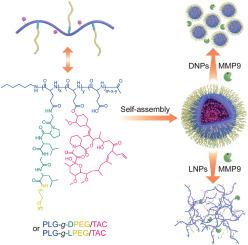Biomaterials ( IF 14.0 ) Pub Date : 2024-01-19 , DOI: 10.1016/j.biomaterials.2024.122476 Feixiang Luo , Mingqian Li , Yuguo Chen , Shifei Song , Haiyang Yu , Peng Zhang , Chunsheng Xiao , Guoyue Lv , Xuesi Chen

|
Acute rejection is a life-threatening complication after liver transplantation. Immunosuppressants such as tacrolimus are used to inhibit acute rejection of liver grafts in clinic. However, inefficient intragraft accumulation may reduce the therapeutic outcomes of tacrolimus. Here, an enzyme-responsive nanoparticle is developed to selectively enhance the accumulation of tacrolimus in liver allograft through enzyme-induced aggregation to refine immunotherapeutic efficacy of tacrolimus. The nanoparticles are composed of amphiphilic tacrolimus prodrugs synthesized by covalently conjugating tacrolimus and matrix metalloproteinase 9 (MMP9)-cleavable peptide-containing methoxy poly (ethylene glycol) to poly (l-glutamic acid). Upon exposure to MMP9, which is overexpressed in rejected liver allografts, the nanoparticles undergo a morphological transition from spherical micellar nanoparticles to microscale aggregate-like scaffolds. Intravenous administration of MMP9-responsive nanoparticles into a rat model of acute liver graft rejection results in enhanced nanoparticle accumulation in allograft as compared to nonresponsive nanoparticles. Consequently, the MMP9-responsive nanoparticles significantly inhibit intragraft inflammatory cell infiltration and proliferation, maintain intragraft immunosuppressive environment, alleviate graft damage, improve liver allograft function, abate weight loss and prolong recipient survival. This work proves that morphology-switchable enzyme-responsive nanoparticles represent an innovative strategy for selectively enhancing intragraft accumulation of immunosuppressive agents to improve treatment of liver allograft rejection.
中文翻译:

免疫抑制酶响应纳米颗粒可增强同种异体肝移植物中的积累以克服急性排斥反应
急性排斥反应是肝移植后危及生命的并发症。临床上使用他克莫司等免疫抑制剂来抑制肝移植的急性排斥反应。然而,移植物内的低效积累可能会降低他克莫司的治疗效果。在此,开发了一种酶响应纳米颗粒,通过酶诱导的聚集选择性增强他克莫司在同种异体肝移植物中的积累,以提高他克莫司的免疫治疗功效。该纳米颗粒由两亲性他克莫司前药组成,该前药是通过将他克莫司和基质金属蛋白酶9(MMP9)可裂解的含甲氧基聚(乙二醇)肽共价缀合至聚( l-谷氨酸)而合成的。当暴露于在排斥的同种异体肝移植物中过度表达的 MMP9 时,纳米颗粒经历从球形胶束纳米颗粒到微型聚集体样支架的形态转变。与无反应性纳米颗粒相比,将 MMP9 反应性纳米颗粒静脉注射至急性肝移植排斥大鼠模型中,可导致同种异体移植物中纳米颗粒的积累增强。因此,MMP9响应纳米颗粒显着抑制移植物内炎症细胞浸润和增殖,维持移植物内免疫抑制环境,减轻移植物损伤,改善同种异体移植肝功能,减轻体重减轻并延长受体生存期。这项工作证明,形态可转换的酶响应纳米粒子代表了一种选择性增强移植物内免疫抑制剂积累以改善同种异体移植排斥反应的治疗的创新策略。



























 京公网安备 11010802027423号
京公网安备 11010802027423号